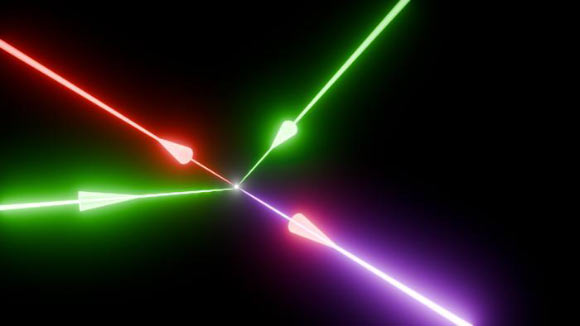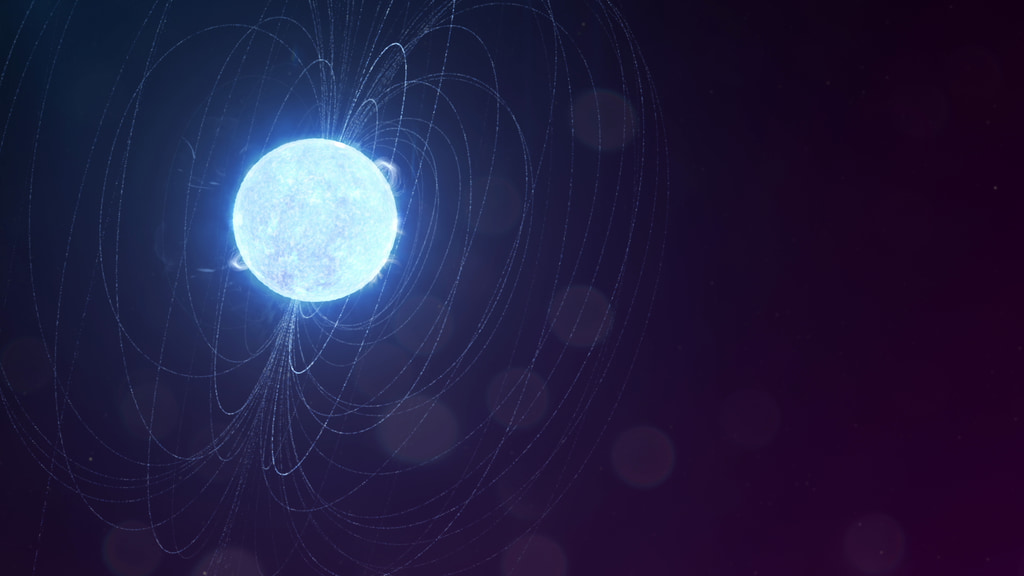Physicists have achieved the first-ever real-time, 3D simulations of how intense laser beams alter the quantum vacuum — a state once assumed to be empty, but which quantum physics predicts is full of virtual electron-positron pairs. Excitingly, these simulations recreate a bizarre phenomenon predicted by quantum physics, known as vacuum four-wave mixing; this states that the combined electromagnetic field of three focused laser pulses can polarize the virtual electron-positron pairs of a vacuum, causing photons to bounce off each other like billiard balls — generating a fourth laser beam in a ‘light from darkness’ process.
Illustration of photon-photon scattering in the laboratory: two green petawatt lasers beams collide at the focus with a third red beam to polarise the quantum vacuum; this allows a fourth blue laser beam to be generated, with a unique direction and color, which conserves momentum and energy. Image credit: Zixin (Lily) Zhang.
“This is not just an academic curiosity — it is a major step toward experimental confirmation of quantum effects that until now have been mostly theoretical,” said University of Oxford’s Professor Peter Norreys.
The simulations were carried out using an advanced version of OSIRIS, a simulation software package which models interactions between laser beams and matter or plasma.
“Our computer program gives us a time-resolved, 3D window into quantum vacuum interactions that were previously out of reach,” said Zixin (Lily) Zhang, a doctoral student at the University of Oxford.
“By applying our model to a three-beam scattering experiment, we were able to capture the full range of quantum signatures, along with detailed insights into the interaction region and key time scales.”
“Having thoroughly benchmarked the simulation, we can now turn our attention to more complex and exploratory scenarios — including exotic laser beam structures and flying-focus pulses.”
Crucially, these models provide details that experimentalists depend on to design precise, real-world tests including realistic laser shapes and pulse timings.
The simulations also reveal new insights, including how these interactions evolve in real time and how subtle asymmetries in beam geometry can shift the outcome.
According to the team, the tool will not only assist in planning future high-energy laser experiments but could also help search for signs of hypothetical particles such as axions and millicharged particles — potential candidates for dark matter.
“A wide range of planned experiments at the most advanced laser facilities will be greatly assisted by our new computational method implemented in OSIRIS,” said Professor Luis Silva, a physicist with the Instituto Superior Tecnico at the University of Lisbon and the University of Oxford.
“The combination of ultra-intense lasers, state-of-the-art detection, cutting-edge analytical and numerical modelling are the foundations for a new era in laser-matter interactions, which will open new horizons for fundamental physics.”
The team’s paper was published today in the journal Communications Physics.
_____
Z. Zhang et al. 2025. Computational modelling of the semi-classical quantum vacuum in 3D. Commun Phys 8, 224; doi: 10.1038/s42005-025-02128-8

























